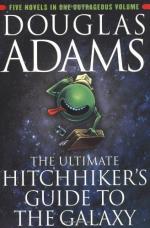|
This section contains 405 words (approx. 2 pages at 300 words per page) |
Galaxies
Nearly all the matter in the universe is concentrated in galaxies. A galaxy is a gigantic mass of stars held together by gravity. The largest contain millions of stars. The smallest have just a few million, but even small galaxies are so big that light takes thousands of years to cross them. Despite having so much matter, galaxies are mostly empty space, with vast distances between each star. Our sun and all the stars we can see with the naked eye belong to just one galaxy - the Milky Way. Beyond this lie billions of galaxies stretching as far into space as astronomers can see.
Elliptical Galaxies
Most galaxies are egg-shaped (elliptical). There galaxies are made up of masses of old, red stars that all formed around the same time. Elliptical galaxies have no gas for making new stars. The elliptical galaxy M87 (left) is the largest galaxy known. It contains 3 million million stars - 15 times as many as our Milky Way. Hidden in its centre is a massive black hole.
Spiral Galaxies
The most spectacular galaxies are spiral. These spin around like giant whirlpools, spreading their stars into graceful trailing arms. The oldest stars are located in a dense central hub. The spiral arms contain young stars, pink nebulas, and dark lanes of gas and dust. Spiral galaxies are disk-shaped, so they appear flat if we see them from the side. Our Milky Way is a spiral galaxy.
Irregular Galaxies
Galaxies with no recognizable shape are called irregular. They are usually small, with lots of young stars and bright gas clouds where new stars are forming. A typical example is the Large Magellanic Cloud (right). At 160,000 light years away, it is one of the closest galaxies and is visible to the naked eye as a pale smudge. It has only 10 billion stars - our Milky Way has 20 times more. The large Magellanic Cloud is trapped by the Milky Way's gravity and orbits it every 6,000 million years. Eventually, the Milky Way's gravity will tear it apart and the two galaxies will merge.
Cosmic Collision
Most galaxies are incredibly far apart, but some get close enough to collide. This picture shows two spiral galaxies crashing into each other. Their cores are orange. Individual stars do not collide, but dust clouds do, triggering a firestorm of star birth. The clusters of newborn stars in this picture look blue. The dark areas are dust clouds.
|
This section contains 405 words (approx. 2 pages at 300 words per page) |


